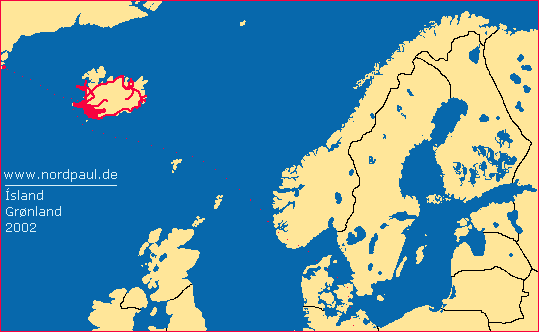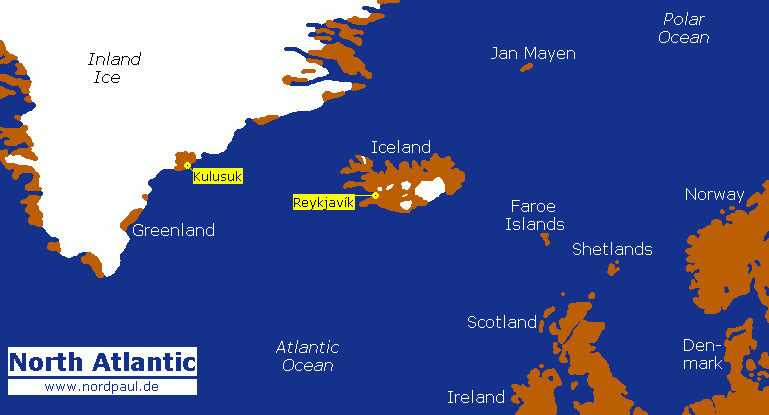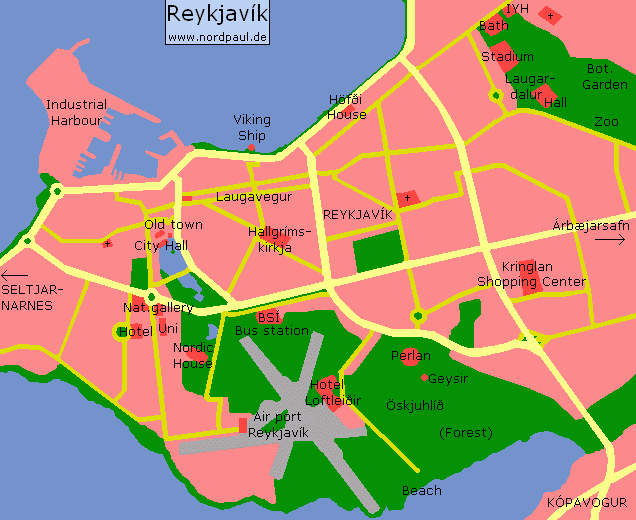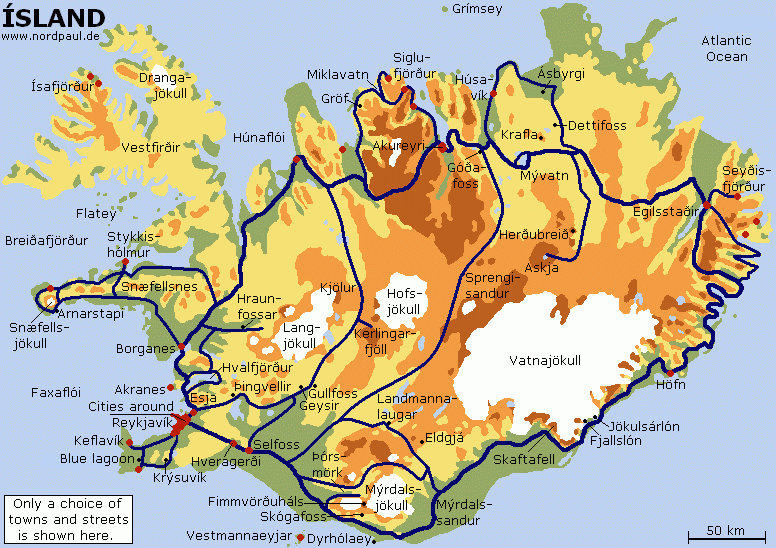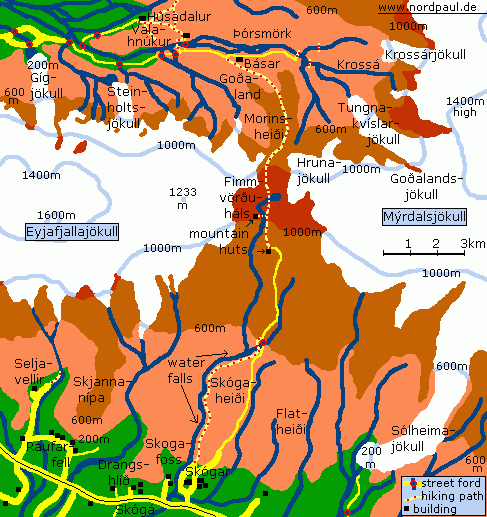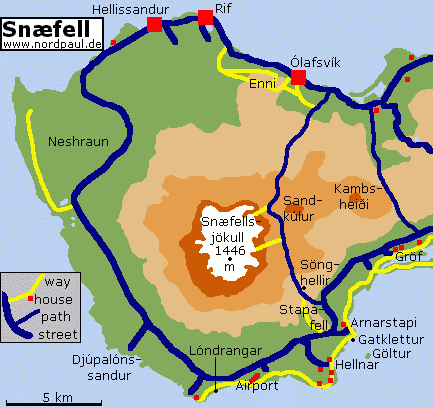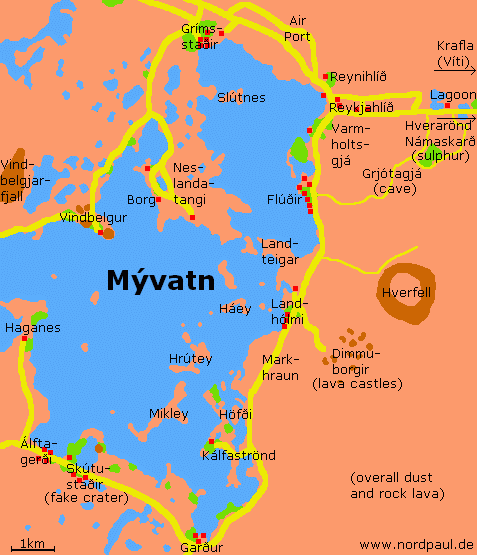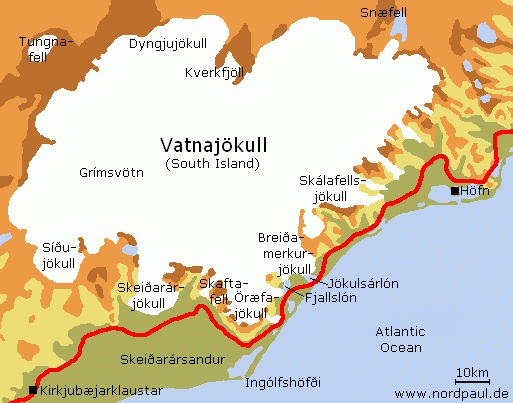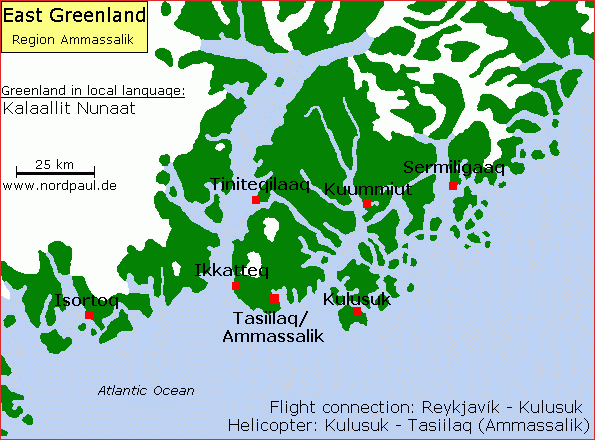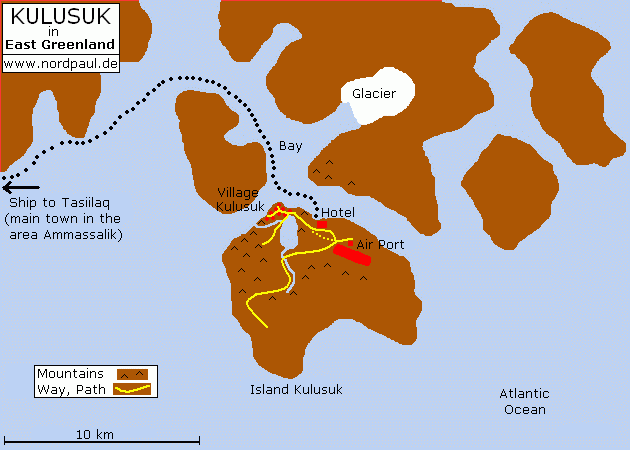Iceland and Greenland 2002
In 21 weeks on Iceland and Greenland I took 720 pictures of the nature and the buildings.
For this website I tried to find out the 87 best photos. This is my choice...
In the year 2002 I spent the practical term of my study in Iceland. I flew to Iceland at the 7th of April 2002 for working there 18 weeks. In the last three weeks I went completely around the island. The 30th of August was my day for flying back to Germany.
During the eighteen weeks I was living in the Icelandic capital Reykjavík. Not far away from the flat there was the hill Öskjuhlíð and the large water tank Perlan with a great viewing point and a restaurant.
 |
 |
 |
 |
 |
| Reykjavík |
Hallgrímskirkja |
Perlan |
Öskjuhlíð |
Clouds |
Reykjavík is situated in the southwest of Iceland and has over 110 000 inhabitants. In the whole capital area (more than five cities) are living around 170 000 inhabitants. So nearly two thirds of the Icelandic population are living in Reykjavík and the suburbs.
In the east of Reykjavík you can find the open air exhibition Árbæjarsafn with different settlement forms of Icelandic history (harbour, farm, town). And at the border of the capital begins already the vast scanty country with all its characteristic signs, for example the coloured hills of Rauðhólar.
 |
 |
 |
 |
| Árbæjarsafn |
Beach |
Rauðhólar |
Mosfellsbær |
Not far away from Reykjavík are two interesting places: the mountain Esja and the historical place Þingvellir.
Esja is up to 901 meter high. You can see the mountain from nearly every place in Reykjavík. During my first hiking tour it was rather stormy and cold. An one way hike to the top took me around 1.5 hours.
The first parliament of the world (the original Althing) was founded in Þingvellir in the 930 AD. Each year in June a large crowd met in the ravine Almannagjá for two weeks for discussing, dealing and celebrating together. This ravine is part of the continental column between Europe and America. There are annually disk movements of approximately four millimeter. The Öxará waterfall flows over the edge of the upper plate down to the other one.
 |
 |
 |
 |
 |
 |
| on Esja |
Ice river |
Esja |
Almannagjá |
Þingvellir |
Öxará |
The Blue Lagoon (Bláa Lónið) is situated half an hour away from Reykjavík. A mineral-rich bathing place is carved out of the lava fields. An industrial company for skin care products, current and hot water supply leads the remaining hot water into the lagoon. And it is very pleasant to have a hot bath at air temperatures around zero degree.
I recommend you a visit of the geothermal area Krýsuvík on the Reykjanes peninsula. There you can find many steam vents, mud pools and sulphur deposits. Oxidized gases arranged a very coloured landcsape. Still today sulfur steams bubble out of the ground and let the mud pots appear in many different colours.
 |
 |
 |
 |
| Blue Lagoon |
Lava |
Krýsuvík |
Nature |
The Big Geyser with its sixty meter high water eruptions was not active in the year 2002. But the smaller Strokkur is very active and erupts every about five minutes to a height of hundred feet (15 m). And there is more you have to visit, for example the hot water hole Bláhver.
The waterfall Gullfoss consists of two diagonally to each other standing stages with fourteen and eighteen meter drop depth. During my first trip in May it was so cold that water drops froze at the other side of the canyon.
 |
 |
 |
 |
 |
| Strokkur |
Big Geysir |
Bláhver |
Gullfoss ice |
Gullfoss |
The sixty meter high Skógafoss is near the settlement of Skógar at the south coast. This waterfall is the conclusion of more than twenty falls at the river Skógá. For me it was a great hike along this river to the mountain hut in Fimmvörðuháls and then down to Þórsmörk. During this hike you can see or guess the glacier Eyjafjallajökull on the left and Mýrdalsjökull on the right hand.
 |
 |
 |
 |
 |
| Skógafoss |
more falls |
Gluggaf. |
Neðstif. |
Seljalandsfoss |
After one night in the mountain hut Fimmvörðuháls I continued hiking down to Þórsmörk. An extraordinary landscape accompanied me the whole time: glaciers, snow fields, plain or pointed mountains, deep valleys and many rock, stone and sand deserts.
Þórsmörk is a very popular hiking and camping area of the Icelanders and lies in the lee of three glaciers. Therefore this valley has its own weather. And sometimes it is very good.
 |
 |
 |
 |
 |
 |
| Fimmvörðuháls |
Sky |
Morinsheiði |
Þórsmörk |
Mýrdalsj. |
Eyjafjallajökull |
North of the Mýrdalsjökull lies a very varied landscape with black dust deserts, volcanic activities and waterfalls surrounded by every colour.
Eldgjá is the most extensive explosion fissure in the world. It is a thirty kilometer long rift, 600 meter wide and partly 200 meter deep. The waterfall Ófærufoss falls into the rift. A natural stone bridge crashed some years ago during an earth quake.
 |
 |
 |
 |
| Axlarfoss |
Canyon Eldgjá |
Markarfljót |
Silvurfoss |
In the interior stone and sand desert lies Landmannalaugar between multi-coloured rhyolite rock formations and lava fields. You can find there an oasis of flowers and green gras because of a hot spring river. Somewhat cooler water is mixed up with the hot water for a great bathing temperature. Sitting in this comfortable warm water is possible 24 hours a day and 365 days a year - and at every kind of weather.
 |
 |
 |
| Landmannalaugar |
warm river |
Oasis |
Kerlingarfjöll is a volcanic massif close to the Hofsjökull. The mountains are up to 1477 meter high. Sulfur steams are still colouring the rhyolite mountains in many colors. There were only a few minutes between sunset and sunrise at summer solstice.
 |
 |
 |
| Kerlingarfjöll |
North |
Midnight |
In the west of Iceland between the Reykjavík peninsula and the West Fjords you can find the peninsula Snæfellsnes. The round majestic glacier Snæfellsjökull (situated at the end of Snæfellsnes) is only visible at some days with clear cloudless weather. The south coast near Arnarstapi shows different basalt formations, interesting cliffs and sea stacks abundant in bird life. I recommend you also the black stone beach Djúpalónssandur at the west end of the peninsula.
In the northeast to the Snæfellsnes peninsula is Stykkishólmur at the Breiðafjörður. From the beautiful harbour the ferry "Baldur" goes to the island Flatey and to the West Fjords.
 |
 |
 |
 |
 |
 |
| Djúpalónssandur |
Gatklettur |
Basalt |
Breiðafjörður |
Flatey |
Stykkishólmur |
At the end of Hvalfjörður lies the highest waterfall of Iceland, the Glymur with 190 meter. Hraunfossar is a waterfall flowing out of a lava field and running down a broad stretch of riverbank - very interesting.
In the north at the Skagafjörður you find the lake Miklavatn and the turf church Gröf. The grass-covered wooden church originates from the 17. Century and has 1.5 meter large walls. The surrounding cemetery is circular.
Near Akureyri at the ring road the Goðafoss falls twelve meter into the depth.
 |
 |
 |
 |
 |
| Glymur |
Hraunf. |
Miklavatn |
Church Gröf |
Goðafoss |
Old renovated boats start to whale watching tours in Húsavík several times a day. You can see minke whales, dolphins and sometimes also a humpback whale. And do not forget to visit the Whale Centre at the harbour.
The river Jökulsá á Fjöllum takes its way from the Vatnajökull across the highlands to the north coast. The river formed a horseshoe-shaped canyon long time ago. This canyon is called Ásbyrgi and part of the Jökulsárgljúfur National Park.
Not far away from Ásbyrgi is Dettifoss, the waterfall with the greatest water flow in Europe. The troubled water falls on a width of hundred meter in a depth of 44 meter. The basalt canyon looks scanty and unreal.
 |
 |
 |
 |
 |
| Húsavík |
Tjörnes |
Ásbyrgi |
Dettifoss |
Canyon |
The lake Mývatn is well known for its mosquitoes, but mostly they do not sting, just nerve. In the south there are some fake craters: Skútustaðir. In many other places the influence of the lava is also visible.
Northeast of the lake is an other warm lagoon which is similar to the Blue Lagoon (but free admission). Behind the Hverarönd mountains you will see the steam clouds of the sulphur area Námaskarð with its many mud and bubbling hot pools.
 |
 |
 |
 |
| Mývatn |
Skútustaðir |
Námaskarð |
Lagoon |
There is a highland bus connection from Reykjahlíð at lake Mývatn into the interior lava deserts. One bus stop is at Herðubreið, the Queen of Icelandic Mountains. It is a 1682 meter high round mountain. The goal of the day trip is the Caldera Askja with its 40 square kilometer. The recently active volcano Víti in the Caldera Askja altered the landscape by a massive volcanic eruption in the year 1875. At that time two square kilometer pumice ash were flung into the atmosphere in approximately 24 hours.
Many long fjords are situated in the south east of Iceland. Because the roads follow the coast lines of these so called East Fjords you will see every fjord from both directions (vista to the Atlantic and to the interior).
 |
 |
 |
 |
 |
 |
| Herðubreið |
River |
Askja |
Drekagil |
Eastfjords |
Seyðisfjörður |
The Vatnajökull is the really largest glacier in Europe with 8300 square kilometer. Dozens of glacier tongues are flowing down into all directions and all valleys. At the ends are often glacier lakes such as Jökulsárlón or Fjallslón. These two lakes are full of melting icebergs on its way to the Atlantic.
The Skaftafell National Park and the basalt columns waterfall Svartifoss are near the highest top of Iceland: Hvannadalshnúkur (2119m).
Dyrhólaey (the door hill island) is the south cape of Iceland. And there is the typical black basalt again.
 |
 |
 |
 |
 |
 |
| Atlantic Beach |
Dyrhólaey |
Jökulsárlón |
Fjallslón |
Skaftafell |
Svartifoss |
On a long weekend I flew for four days from Reykjavík to Greenland (in Danish: Grønland, Inuit language: Kalaallit Nunaat). At the east coast of Greenland is the village Kulusuk on an island with the same name. The airport and the hotel lie a few kilometer away from the settlement, however they offer the almost only jobs for the population.
Kulusuk is one of the outer islands in East Greenland and lies south of the polar circle. You can not see the big inland ice because it is behind the high mountains. But there is a glacier at the opposite shore of the bay. The whole bay was still covered with thousands of icebergs and floes in the beginning of August. Depending upon wind and tide the ice flows into the bay or out to the Atlantic Ocean.
 |
 |
 |
 |
 |
| Air plane |
Overview |
Fog top |
Cemetery |
Mist |
Approximately 300 Inuit (Greenlandic "natives") are living in Kulusuk today. An Icelandic family operates the youth hostel in one of the coloured framehouses. It consists of two sleeping rooms, a toilet and a kitchen with a table and some cooking facilities. The patrol furnace is adventurously loud, but warm for some hours.
In the center of Kulusuk there is a shop with a good selection of food and other things. At the other side of the gravel road you find a tourist shop and the community center. Perhaps there is the only shower of Kulusuk. Most of the individual houses do not have a water pipe. The reason is the ground. You have only rock and stones. It is not possible to lay frost-resistant water pipes to every building. However automatic water pumps are situated everywhere in the village.
 |
 |
 |
 |
 |
| Kulusuk |
on the top |
Fresh water |
IYH |
Village |
» Conclusion
Iceland is one of the most expensive countries of Europe. Only a few things are relativly cheap in Iceland: mobile phones, patrol/gasoline and all kinds of water: a glass of water is for free in the restaurant/ natural warm open-air swimming pools (hot spots) cost only 200 ISK (approx. 2.40 EUR, in the year 2002).
Some price examples of the cheapest supermarket "Bónus" (in EUR): 2 litre juice 3,50/ 1 litre milk 0,90/ small cookies 1,20/ wheat bread 1,30/ 12 eggs 2,30/ 150gr ham 2,10/ pizza 3,50/ 8 rolls toiletpaper 4,-. In all other (more expensive) supermarkets you have to add 20 to 50 percent. PS: Half a litre Finlandia-Vodka costs in a special public store 22,- EUR.
In Greenland the things are a little more expensive than in Iceland because they have to import nearly everything. Accomodation is also not cheap. A flight from Iceland to Greenland and back costs about 500,- EUR.
Iceland and Greenland? More than just a short trip!
If you want you can correct my English because it is not my native language.
Just send me an e-mail: webmaster@nordpaul.de
» Links
Last modified: 2018/04/26
♥ Privacy means: no tracking, no cookies, no third-party ad servers or ad networks. ♥
© nordpaul.de - Pictures of Northern Europe
- nordpaul.de - North Europe - Site Terms - [deutsch] -
Iceland Greenland Reykjavík Esja Þingvellir Krýsuvík Geyser Gullfoss Skógafoss Fimmvörðuháls Þórsmörk Eldjá Landmannalaugar Kerlingarfjöll Djúpalónssandur Flatey Gröf Dettifoss Mývatn Námaskarð Herðubreið Askja Vatnajökull Jökulsárlón Kulusuk




